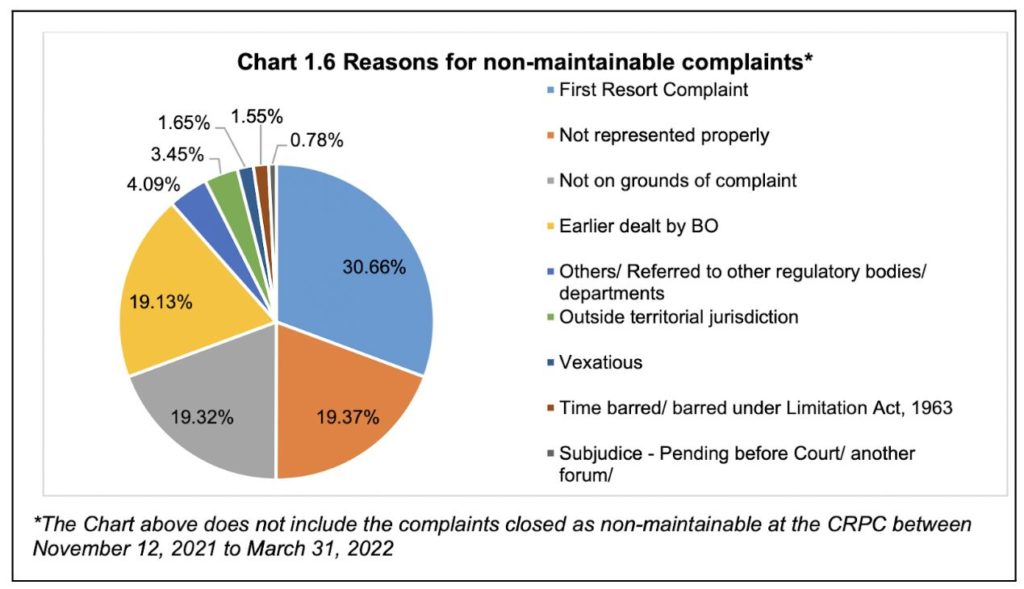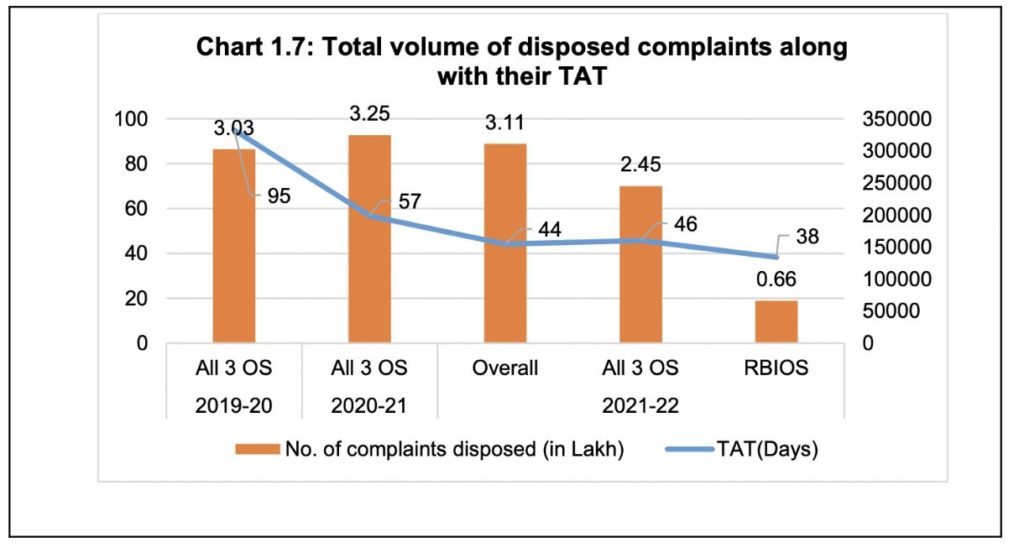Data from the RBI’s annual report on the ‘Ombudsman Schemes’ indicates that the overall disposal rate increased to 98% in 2021-22. The data also indicated that the TAT has decreased after the introduction of integrated scheme. It remains to be seen if this trend continues in the coming years.
An effective Ombudsman scheme not only provides a platform for customers to register their grievances but also ensures the disposal of these complaints in a quick and effective manner. Disposal of grievances was fairly effective in the earlier existing three banking-related ombudsman schemes, with a disposal rate of more than 90%. A key component of the newly introduced RBI’s Integrated Ombudsman Scheme was to facilitate an easier process of lodging complaints. Another major feature of this framework was the introduction of CRPC, through which the grievances were screened and forwarded to the Ombudsman office (ORBIO). With the disposal of a substantial number of complaints by CRPC, fewer complaints are expected to be handled by ORBIOs, thereby providing them with more bandwidth for effective and quicker resolution of the complaints.
In the first story of this two-part series, we highlighted that even though the number of total complaints with the ombudsman has increased in 2021-22, the number of complaints handled by ORBIO reduced, with CRPC disposing of around 1.14 lakh complaints. In this story, we look at the trends in the disposal of complaints.
Note: The data for 2021-22 was provided for the period April-March, in line with the change in the Fiscal year of RBI. However, the data for disposals in the earlier years was for the July-June period. The data for 2019-20 data is for the period July’2019 -June ‘2020, whereas for 2020-21, the information is provided for the 9-month period of July’2020-March’2021. Hence, the numbers may be proportionate.
98% of the complaints received by ORBIOs in 2021-22 were disposed
A total of 3.04 lakh complaints were received by all the ORBIOs during 2021-22 (April -March). These do not include the complaints that were resolved by CRPC during the year. Further, 11.4 thousand complaints were carried forward from the previous year. Hence, a total of 3.17 lakh complaints were handled by ORBIOs during 2021-22. This includes the complaints received from the three erstwhile schemes as well as the integrated scheme.
Out of these, 3.11 lakh complaints i.e., 97.9% of the complaints were disposed. This is comparatively higher than in 2020-21. As per the data provided for the 9-month period of July’19 to March’20 for 2020-21, a total of 3.35 lakh complaints were handled out of which, 3.23 lakh complaints were disposed. The disposal rate during this period is 96.6%. During the full year of 2019-20 (July-June), 3.17 lakh complaints were disposed out of 3.42 lakh handled during the year. Hence the disposal rate was 92.5%.
The number of complaints carried forward to 2021-22 from the previous year was comparatively less than in previous years which has contributed to a higher disposal rate.
Increase in the share of Rejected complaints
Maintainable complaints are those that are valid under the ambit of the scheme. In 2021-22, 1.75 lakh maintainable complaints were disposed. Out of these, 1.11 lakh complaints were disposed through Mutual Settlement/Agreement. This is 63% of the maintainable complaints.
Although this mode remains the major form of disposal even in 2021-22, the share has reduced compared to earlier years. During the 9 months of July’2020 to March’2021, 72.7% of the complaints were disposed through mutual agreements or settlement. During 2019-20 (July to June), this was 72%.
There is an increase in the share of disposal of maintainable complaints through rejection. This increased from around 27% in the earlier years to nearly 36% in 2021-22. The Annual report does not provide information on the reasons behind the rejection of maintainable complaints.
There is also an exponential increase in the withdrawn complaints among the maintainable ones. During 2019-20 and 2020-21, it was 182 & 197 respectively. But during 2021-22, it increased to 952. There is also a drop in the disposal by Award. Only 33 complaints were disposed in this mode, compared to 68 & 65 in the two immediately preceding years.
Fall in the share of long pending complaints that are carried forward
6.4 thousand complaints are carried forward to 2022-23 compared to 11.4 thousand complaints that were carried forward to 2021-22 from 2020-21 This is a continuation of the trend, with fewer complaints being carried forward. A total of 25.6 thousand complaints were carried forward from 2019-20. Apart from the fall in the number of complaints that are being carried forward, there is also a fall in the number of long pending complaints.
By end of 2019-20, nearly 54% of the complaints that were carried forward, were pending for more than three months. Comparatively, they constitute only 2.5% of the complaints that were carried forward by end of 2021-22. A higher proportion of the complaints are those that are pending for less than 30 days.
Non-maintainable complaints are 43% of the complaints received by ORBIOs
A complaint received is considered non-maintainable if the nature of the complaint is outside the purview of the Ombudsman or if the complaint has been raised incorrectly. Out of the total complaints received by ORBIOs in 2021-22, nearly 43% i.e., 1.35 lakhs were deemed as non-maintainable. This number does not include 1.14 lakh complaints disposed by CRPC as non-maintainable.
During the period July’2020 -March.2021, there were 1.2 lakh non-maintainable complaints.
The Annual report does not provide any further breakup of the number of non-maintainable complaints received after the implementation of the RBI-IBS framework, which would throw further light on the efficacy of CRPC to reduce the burden on the Ombudsman’s office by disposing of the non-maintainable complaints.
As per the available data, around 39 thousand complaints were considered non-maintainable by the erstwhile BOS, while another 9 thousand were non-maintainable by the ombudsman relating to NBFCs. The available data does indicate that a sizeable number of complaints deemed as non-maintainable were after the new scheme was implemented.
Nearly 31% of the complaints deemed as non-maintainable were disposed because of the reason that they are ‘First Resort Complaints’ i.e., they did not approach the bank prior to raising a complaint with Ombudsman. ‘Not on grounds of Complaint’, ‘Not represented Property’ and ‘Earlier Dealt by BO’ are the other major reasons for non-maintainable complaints.
Efficacy of the new Integrated Ombudsman scheme can only be ascertained in coming years
The lower tenure of the pending complaints indicates a faster disposal of the complaints by the ombudsman. The annual report does highlight the fall in the TAT in disposal of the complaints after the implementation of RBIOS.
However, it cannot be conclusively ascertained if this is the impact of the new ombudsman scheme. Trends from the coming years would provide an indication of the impact of the integrated ombudsman scheme.
Meanwhile, there is an increase in the cost incurred per complaint. In 2021-22, it is Rs. 2,895 per the complaint, while it was Rs.1,599 in 2020-21. The Annual report states that it is due to the additional hiring for the implementation of the new integrated scheme. It also needs to be seen if RB-IOS helps reduce the overall cost in the future.
Featured Image: RBI’s Annual Report on Ombudsman Schemes




